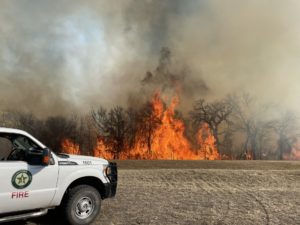Wildfire potential increases in southwest Texas
Firefighters continue to contain several large wildfires from Southern Plains Wildfire Outbreak
Wildfire potential increases March 21 for large, difficult-to-control wildfires to occur in Southwest Texas, specifically for areas near Del Rio, San Angelo, San Antonio and Laredo.
State, local and federal first responders have been increasingly busy with recent response efforts. Over the past seven days, firefighters responded to 178 wildfires that burned 108,493 acres across the state.
March 17 wildfire outbreak
A Southern Plains Wildfire Outbreak occurred on March 17 across west Central Texas. This phenomenon can be compared to the high impact Santa Ana wildfire events that occur in southern California.
On March 17, strong winds and critically dry grasses contributed to extreme fire behavior and rapid rates of spread across the landscape. State, local, federal and military resources responded to 20 wildfires that burned 67,533 acres that day.
“Group torching, the vertical transition of fire from the ground to the canopy of trees in oak and juniper timber was observed on Thursday,” said Luke Kanclerz, Texas A&M Forest Service fire analyst. “Embers and flammable material were spotting up to 150 yards away from the active wildfire.”
Several wildfires, including those managed as the Eastland Complex in Eastland and Brown counties, are still actively burning across the state. The more than 54,000-acre wildfire prompted evacuations and road closures in addition to damaging 147 structures. Eastland County Sheriff’s Deputy Sergeant Barbara Fenley died in the line of duty while assisting with evacuations.
“The extreme conditions present across the state last week greatly impacted several communities and the Texans who live there,” said Wes Moorehead, Texas A&M Forest Service fire chief. “These communities endured significant loss, and we grieve with them.”
Wildfire resources
The Geographic Area Coordination Centers’ Southern Area Gray Type 3 Incident Management Team assumed command of the fires over the weekend, working alongside Texas A&M Forest Service. However, with increasing complexity, the Southern Area Blue Type 1 Incident Management Team has been mobilized to manage the fires and will be in state mid-week to assist.
On March 20, three new wildfire ignitions in Eastland County were absorbed into the Eastland Complex for management purposes. The complex, now 30% contained as a whole, consists of seven wildfires: Kidd Fire, Eastland County, 42,333 acres, 40% contained; Blowing Basin Fire, Eastland County, estimated 241 acres, 50% contained; Cedar Mountain Fire, Eastland County, 250 acres, 10% contained; Oak Mott Fire, Brown County, 4,031 acres, 75% contained; Wheat Field Fire, Eastland County, 7,268 acres, 55% contained; Mangum Fire, Eastland County, 11 acres, 85% contained; and Walling Fire, Eastland County, 383 acres, 100% contained.
Increased wildfire activity was observed on March 20 along and west of I-35, where critically dry grass across the landscape was exposed to elevated-to-critical fire weather. This also included higher wind speeds and low humidity.
Fire resources responded to 37 wildfires that burned 16,081 acres on March 20, which includes the still-burning Big L Fire in Erath and Hood counties. These burned an estimated 11,000 acres and are about 20% contained. They also included the Ramsey Fire in Brown County, which burned an estimated 1,500 acres and is about 5% contained.
“First responders from across the state and country have answered the call for assistance,” said Moorehead. “The tremendous response effort over the past four days has been nothing short of remarkable.”
Wildfire potential continues
Texas A&M Forest Service is monitoring the current situation closely and has prepositioned personnel and equipment across the state for a quick and effective response to any requests for assistance.
Fully staffed task forces and additional suppression equipment are staged in Alice, Amarillo, Beeville, Brownwood, Burkburnett, Childress, Edinburg, Fort Stockton, Fredericksburg, Lubbock, McGregor, Merkel, Mineral Wells, Pleasanton, San Angelo, Smithville and Victoria.
Additionally, fire-line supervisors, command staff and incident commanders with advanced qualifications are strategically placed across the state to respond. Resources from 14 states have been mobilized to Texas to support wildfire response efforts.
Aircraft were heavily utilized over the past week to support suppression efforts on the ground, aiding in the protection of structures and other valuable resources.
Thirty-four aviation resources are currently staged in state, including three large air tankers, 15 single engine air tankers, four air attack platforms, two aerial supervision modules, three Type 1 helicopters, two Type 3 helicopters, four Blackhawks, one Chinook and one multi-mission aircraft.
Eleven strike teams are mobilized via Texas Intrastate Fire Mutual Aid System. Texas A&M Forest Service has requested the mobilization of three additional strike teams for wildfire incident support.
Responders are asking Texans to stay wildfire aware. If a wildfire is spotted, immediately contact local authorities. A quick response can help save lives and property.
For current conditions and wildfire outlook, visit the Texas Fire Potential Outlook https://bit.ly/3kemhbG.
Texas A&M Forest Service does not own any aviation resources but instead uses federal aviation contracts through the U.S. Forest Service and Bureau of Land Management for all firefighting aircraft.



